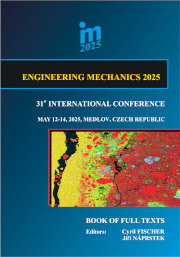Proceedings Vol. 31 (2025)

ENGINEERING MECHANICS 2025
May 12 – 14, 2025, Medlov, Czech Republic
All papers were reviewed by members of the scientific committee.
ISBN 978-80-86246-99-4 (electronic)
ISSN 1805-8248 (printed)
ISSN 1805-8256 (electronic)
scientific committee — home
Chapter 2: Advances in Biomechanics
The acoustic volume velocity transfer function of a vocal tract characterizes its acoustic resonance properties, which are important for human voice production. In this paper, the computed and measured transfer functions of the vocal tract model are compared. The procedure of measuring the transfer function is then applied to the vocal tract model completely closed by the silicone vocal folds model. The influence of the vocal folds’ stiffness on the vocal tract transfer function and also on the acoustic response spectra during simulated phonation was found to be very important - especially in higher frequency regions.
This study aimed to evaluate the influence of steady flow on the position of resonant peaks of human voice for phonation of vowel [a:] and its use for the energy redistribution in the frequency spectrum during the singing. The study applied 3D volume models of the vocal tract based on computer tomography images of a female speaker converted to the simplified 1D model assembled from the cylindrical elements. The 1D model considers the acoustic energy dissipation due to friction losses inside the vocal tract and emitting energy from the mouth. The steady flow higher than 3 l/s shift resonance F3 and F4 to the lower values and increases positively the amount of acoustic energy in the frequency interval 2.5-4 kHz and can influence support the stronger voice production.
This paper presents a comprehensive study on the modal analysis of the cranium (also the Latin term for the human skull) using both experimental and numerical approaches. The primary objective is to determine the natural frequencies and modal shapes of the cranium, which characterize its dynamic behavior under various conditions. Understanding these properties is essential in fields such as biomechanics and forensic science, as well as medical applications, including surgical planning and trauma analysis. The study details the methodology for conducting experimental measurements and numerical simulations, highlighting the techniques used to capture the cranium’s vibrational characteristics. Additionally, the paper discusses the equipment and software employed in the analysis, ensuring accuracy and reliability in the obtained results. By combining experimental data with computational models, this research contributes to a deeper understanding of the biomechanical properties of the human cranium.
Copyright © 2025 Institute of Theoretical and Applied Mechanics, Czech Academy of Sciences, Prague
All contributions are published under the Creative Commons Attribution 4.0 International License (CC BY 4.0). The copyright remains with the authors. The texts are publicly accessible, and any reuse must include appropriate credit to the original source as required by the license.
